Brass
Part six (of six) of the Ghanaian Handicraft series.
I’ve left the most complex handicraft until the end. I’m ashamed to admit how long it actually took me to figure out just what the heck was going on. A metallurgist, I’m not. But it is also arguably the coolest craft I learned. Here’s why.
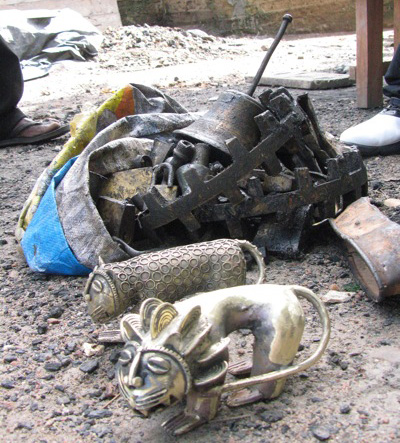
Brass artisans take take the trash of technology — gears, circuit boards, wires, pipes — and transform it into art. It seems so right — such a fitting way to repurpose what otherwise would be non-biodegradable and in some instances toxic. (Glass bead artisans do something similar with discarded bottles.)
Specifically brass workers strip zinc and copper where it can be found and, though the level of impurity is high, they’re able to forage quite a bit.
But let’s back up. Making brass is relatively easy compared to getting it into the shape you want. Basically the art in this craft is all about the mold. It starts with long strings of honeybee wax. How the wax is shaped is exactly how the envisioned product will look. That is, where wax is in your model is where the liquid brass will harden. So get it right.
Charcoal is the material around which or through which you place the wax. It holds things in place. So, as in the video above let’s say you are making hollow, decorative spheres (for a necklace, for instance). A charcoal ball at the middle supports the wax decoration which will eventually becomes the brass.
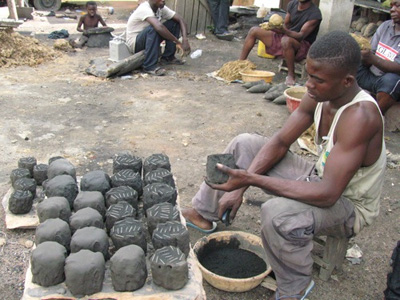
OK, follow me on this. It hurts the brain a bit. Charcoal is packed around the finished wax model too. So basically you have the shape of the final product, in wax, completely surrounded by charcoal. Then this is all encased in a mud and straw crucible.
The key to it all is that there is no wax isolated completely inside the crucible. It all touches some other wax and is finally connected to strands of wax that poke out of the charcoal. See where this is going?
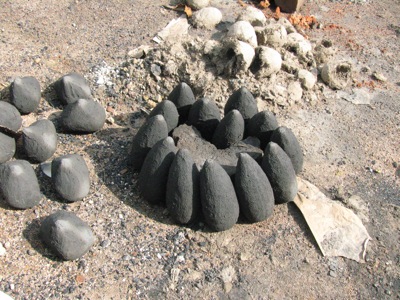
The crucibles are heated around a fire and the wax melts. It is drained out — thanks to nothing being isolated and the “channels” of wax that stick out of the mold. What you have is a perfect inverse mold of what you’re trying to make. Just pour in the brass (melted obviously) and let it set. Chip away the charcoal and voila! Brass from trash.
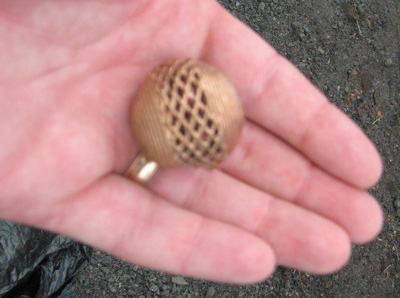
More brass-making video here.
Clay
Part five of the Ghanaian Handicraft series.
As in many cultures, pottery is made from clay in Ghana. Yet as a craft it is hard to find here, largely because it is considered utilitarian, with a market that’s almost completely domestic. People use the pots, bowls, and vessels in everyday life.

Unlike other handicraft that is created at some distance from the source of the raw materials, potting happens close to the river banks that provide the clay, presumably because it’s a pain to move large quantities of the dense, wet material.
We visited the tiny village of Nfensi and were taken to their river. It was one of those glad-I-took-my-malaria-meds moments. (Luckily we were there during the daytime, before the virus-toting Anopheles skeeters come out.)
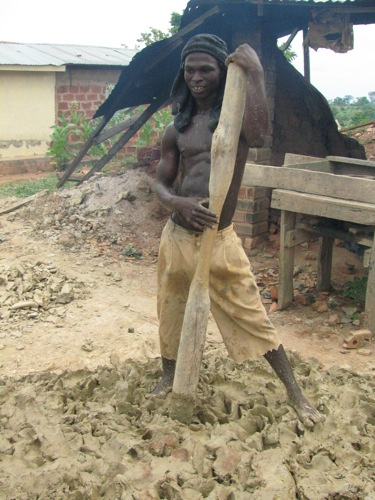
Once hauled up from the water the clay is pounded repeatedly to loosen it up. (The pounder uses the same tool that smashes open yam and cassava for fufu, incidentally.) There’s a further step of kneeding, then the potter slices off as much clay as he’ll need and slaps it on the wheel.
The potter’s wheel is completely manual. One guy cranks it while the master shapes the clay.
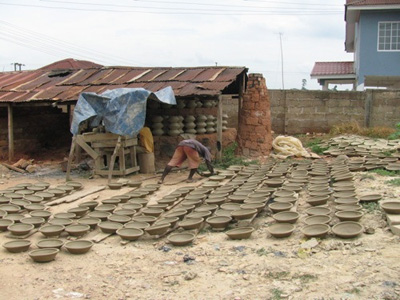
It happens so quickly and effortlessly — probably not surprising given that they turn out approximately 1,000 items every three days.
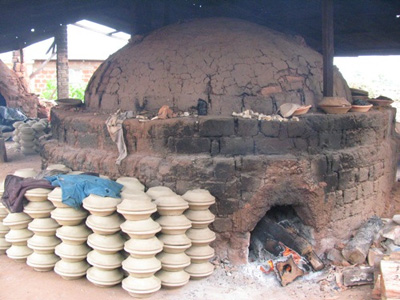
Once dried, the clay objects are prepared for the igloo-shaped kiln. It’s infernally hot around the oven which the artisans actually walk into to stack the clay pots. Then the “door” to the oven is bricked up and the fire is allowed to go for a few days. The door gets broken back down and out come the finished, though unadorned pieces.
There is an export market that consumes larger, more finely decorated pieces, but it is overshadowed by the more “traditional” wooden export market. To many Westerners, Africa means wood carvings (masks, statues, etc). But those consumers who are interested in owning the most “real” African goods — what one study calls “authenticity buyers” — might look to pottery as an alternative.
More clay pottery video here.
Textile
Part four of the Ghanaian Handicraft series.
Few crafts are as closely linked with their place of production than kente cloth weaving is with Ghana. Tradition holds that five villages in the Ashanti region were declared official kente-weaving centers by the first king of Kumasi. Only two of these villages still produce the textile and of these Bonwire (pronounced bon-RAY) is the most famous.
The colored yarn is imported — a rare example of an international supply dependency in Ghanaian handicraft. This may be more a sign of market demand for the widest range of color and, as such, would be a positive thing, evidence of adaptability in an ancient form.
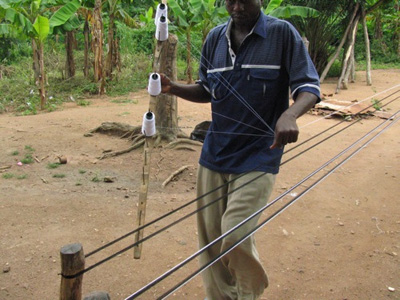
Before being placed on the loom, individually-colored yarn strands are reeded and warped in open outdoor spaces. This basically consists of mixing the colors together manually (by drawing out precise lengths then painstakingly intertwining separate colors) so that the weavers have the color elements pre-assembled when they insert it into the loom. It’s warp and weft sous-cheffing.
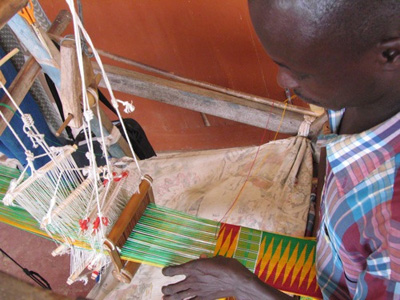
Though mass-produced kente can be churned out from automated looms, the traditional setup is a wooden box that fully engages the limbs of the operator. Feet press on make-shift pedals to raise and lower the separate planes of fabric (which form the kente background) while one hand flits the bobbin of thread in and out (which creates the actual design). The other hand variously adjusts the comb that pounds the new threads into place and a separator that gives the bobbin more room to work. It happens fast.
It’s mesmerizing really, high-technique, high-speed, and in full color. (There’s high tech too. New designs and particularly complex patterns are designed first using a custom computer application. There’s no automation involved, just a pre-design that when printed helps the weavers understand the sequence of overlapping shapes needed to make the end design.)
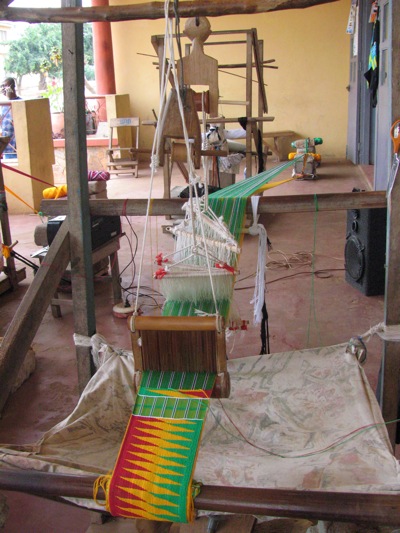
Men — and it is always men, traditionally — work at the looms side-by-side. There’s no talking, no singing, maybe a radio on, but basically just the hypnotic squeak and wooden clatter of the looms.
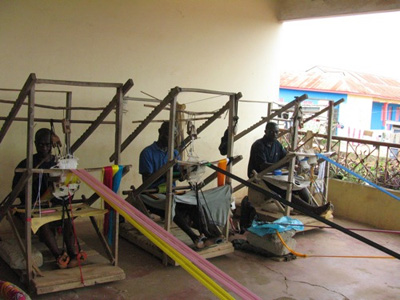
Typically a single 8″ by 5′ section of kente takes a month or more to finish. Sections are sewn together and sold in larger pieces as traditional Ashanti tunics or for Western uses such as duvets and throws.
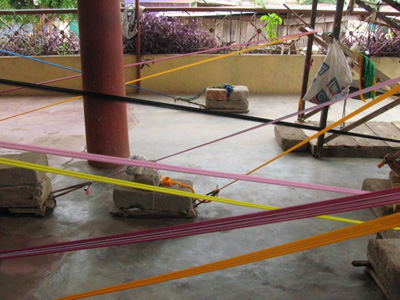
To come across a workshop in Bonwire is to enter a world of bold geometries and colors — a vibrant contrast to the matte earth tones of what is otherwise a fairly poor village.
There’s a cultural center outside of Bonwire that’s totally deserted. (It has a relatively clean toilet; we’ve stopped there twice.) Clearly this was the town’s attempt at capitalizing on its famed craftsmanship — but that plan seems to have run off the rails. If any craft village can become a tourist destination it is Bonwire. Our goal, in part, is to help Aid to Artisans figure out how to do this.
More textile-weaving video here.
Glass
Part three of the Ghanaian Handicraft series.
Glass beads are not an indigenous art form in West Africa. Today’s Ghanaian bead-makers continue a craft introduced by Europeans in the 15th century. Glass beads, made then primarily in Venice, were used as barter for the raw materials that Europeans desired. As glassmaking was not widespread in Africa the articles of fashion made from the beads were highly sought after and, in time, came to be called ‘trade beads,’ a de facto coin of the realm.
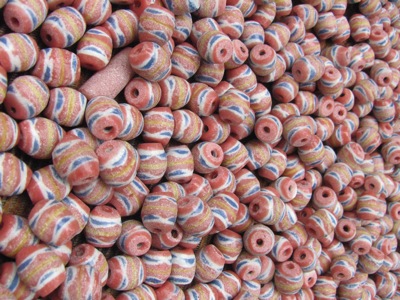
Trade beads were often swapped for slaves. You’ll also hear them referred to as ‘slave beads.’ Unlike some Westerners, contemporary artisans obviously find no dark irony in carrying on a craft meant initially to quantify the worth of a human being. And why should they? Like refusing to salt your fries because it too was once used to barter for slaves.
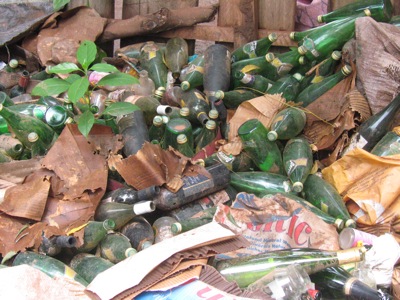
The “raw” materials for the bead-makers are discarded bottles. It’s a wonderful thing, really. At zero cost, the artisans collect up as much glass as they can (though, admittedly it is a bit tougher here than in the West because you can’t buy new bottles of soda, for instance, without returning an empty one). From trash to jewelry — can’t beat that product life-cycle.
The bottles are smashed. And smashed again. And again. Repeatedly until the glass is just a fine, pulverized powder. (Don’t inhale.)
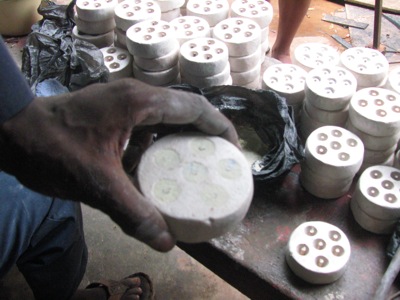
Once in powder form the glass is mixed with various dyes and filled into molds depending on the desired bead shape. Then, into hell’s oven for melting.
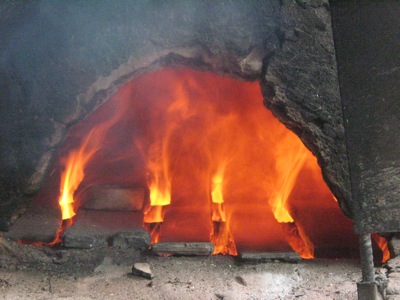
Typically the molds yield semi-circular halves which are then melted together to form spheres. They are then joined on a string, often with differently-colored beads, thanks to the central axle in the mold that preserves a hole through the bead.
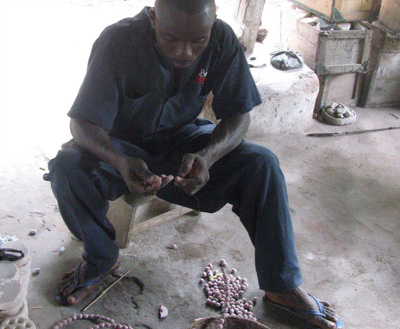
More bead-making video here.
Straw
Part two of the Ghanaian Handicraft series.
Straw weaving is not a craft normally associated with the environs of Kumasi. Mostly that honor belongs to the far northern town of Bolgatanga. (Say that word. Say it now. And enjoy how delightful it is to hear.) But we wanted to get a sense of the craft and it turns out that the actual raw material (the straw) is cheaper nearer to Kumasi. So some small artisans have sprung up.
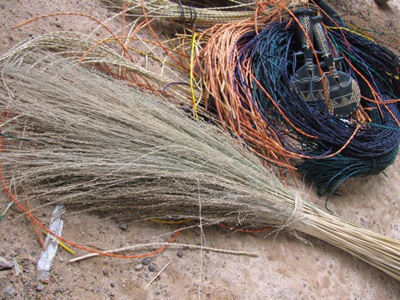
It’s the simplest craft we’ve observed. The most serene too. A single artisan with a bunch of straw strands, some dyed, sets out and weaves the object in mind. No tools; the very definition of handicraft and skill.
It’s a family affair in the small villages that produce straw-woven goods. Everyone seemed so damn happy, just weaving away. They know what they are doing, how to do it, and why they’re doing it. It was inspirational, in a way.
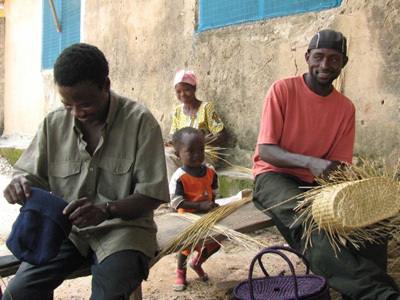
More straw-weaving video here.
Wood
Part one of the Ghanaian Handicraft series.
Wood-carving is one of the oldest craft traditions in Ghana. Wooden sculpture is produced throughout the country and has a high export value. Two weeks ago we visited the village of Ahwiaa to observe and talk to artisans trained in the traditional discipline.
Wood is delivered to them from the forests hewn roughly into the intended shape of the end product. From there small outdoor workshops of carvers set about shaping the objects into final form. The workshops are a welter of flying wood chips, sweat, and clanking. Masters silently instruct their apprentices.
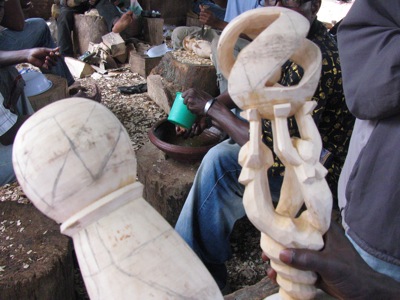
It all seems so random and haphazard, but obviously these gentlemen know what they are doing. And they are all gentlemen. Female woodworking is taboo mostly because of the posture assumed by artisans: the wood chunk is held between the legs and shaped there. Ghanaians disapprove of tools being used in the vicinity of female genitals.

The artisans are preternaturally fit. They look carved from solid material too. The main implement is a metal gouge placed carefully on the wood and then struck by a mallet. The carvers wear two pairs of pants over one another for protection. The outer pants are ripped and frayed from numerous skewed strikes.
We visited the main woodworking area in Ghana, an area of the Ashanti region near Kumasi. Traditionally the king of the Ashanti (called the Asantahene, currently Otumfuo Nana Osei Tutu II) is the custodian of all arts in the region because of the historic relationship between craftsmanship and the royal house. What this means today is that he serves a quasi-governmental position of promotion and support for the arts, including being the nominal patron of our organization Aid to Artisans.
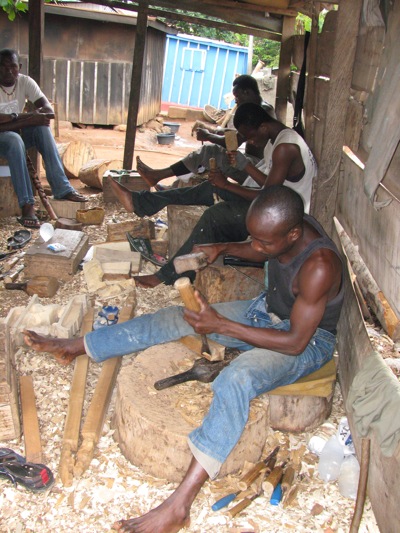
Aid to Artisans does more than just serve as a middleman for the producers. They hold courses on reforestation and forest management for their producers and recently purchased a small section of woodland as a kind of nursery/laboratory for the study of sustainability techniques.
And yet, it seems to be a losing battle. Every day I’ve seen huge trucks hauling massive felled trees. In fact they aren’t really trucks, just two sets of wheels lashed to the mammoth trunks. Even in Kakum, which is protected by law, there is logging taking place. One wonders how much longer this art form can survive without importing lumber.
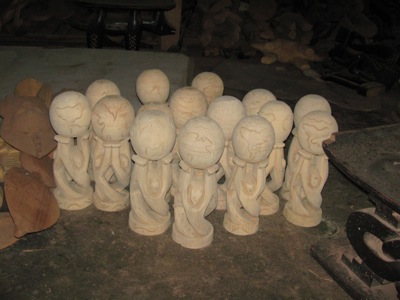
More wood-carving video here.













